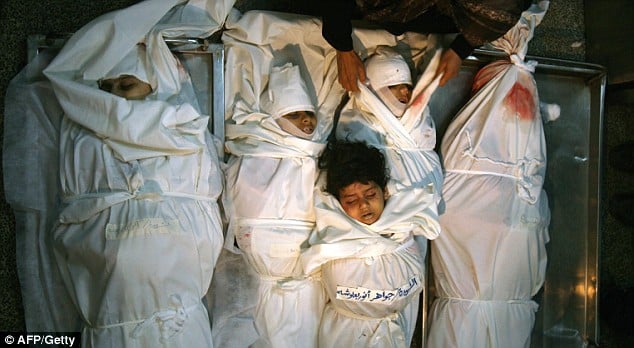The ongoing Israeli entity’s atrocities in the Gaza Strip and calls for displacement of its population have reproduced the 1948 Palestinian expulsion (Nakba) when 957,000 Palestinians, over half of the prewar Mandatory Palestine’s 1.4mn Arab population, were forced to flee their homeland, thousands of them were forcibly displaced in the territories seized by the Israeli occupation.
At this time, the Zionist gangs seized 774 Palestinian villages and cities, 531 of which were completely destroyed, while the rest were subjected to the occupation entity. This cleansing coincided with over 51 massacres, leaving tens of thousands of Palestinians martyrs. In fact, the Nakba was only the outset of a Palestinian tragedy that is still running.
The Deir Yassin massacre in April 1948, was the first Israeli occupation massacre when Zionists killed at least 107 Palestinian Arab villagers, including women and children, in Deir Yassin — a village of roughly 600 people near Jerusalem, despite having earlier agreed to a peace pact. This was followed by the 1953 massacre against the Al Bureij refugee camp and the 1954 massacre against Nahalin, Bethlehem.
On June 5, 1967, the Israeli entity usurped what remained of historic Palestine — East Jerusalem, the West Bank, and the Gaza Strip — along with Syria’s Golan Heights and Egypt’s Sinai Peninsula, in what was known as the Six Day War. In this war, the were huge: 25,000 Arabs were martyred and 80% of the Arab countries military equipment was devastated. Nearly 300,000 Palestinians were displaced from the Gaza Strip and the West Bank, nearly 100,000 Golan residents were forced to quit their homes into Syria, and thousands from the Sinai Peninsula were forced to flee into Egyptian territory. Only 800 Israelis were killed.
In Sept 1982, three-day mass killings in the Sabra and Shatila refugee camp in Lebanon claimed hundreds of people, a horrific collective trauma, the impacts of which are still engraved in the memory of the Lebanese and Palestinians. Five years later, a total of 1,555 Palestinians were martyred in the First Palestinian Intifada, aka Stone Intifada — a comprehensive Palestinian uprising that lasted five years, using stones as a weapon to confront the vehicles and equipment of the occupation army and settlers.
The Second Palestinian Intifada, aka Al-Aqsa Intifada, broke out on Sept 28, 2000 and saw about 4,412 Palestinians martyrs and 48,322 injured.
Israeli occupation repeatedly invaded areas in the West Bank and Gaza Strip including the Operation Defensive Shield, a matter which triggered the Second Intifada after the storming of Al-Aqsa Mosque by then Israeli opposition leader Ariel Sharon under the protection of about two thousand soldiers and special forces and with the approval of then prime minister Ehud Barak, prompting protests by crowds of worshipers and the outbreak of first confrontations in this Intifada.
Palestinian child Mohamed al-Durrah was a Second Intifada symbol. France 2 cameraman on Sept 30, 2000 filmed the then 11-year-old and his father crouching behind a concrete cylinder southern Gaza City, before he was shot dead by Israeli army.
In Sept 2007, the Israeli entity designated Gaza a hostile entity, and in October of the same year, it imposed a comprehensive siege on it. Since this siege, Israel began its Operation Cast Lead against the Gaza Strip, a 23-day offensive to which the Palestinian resistance responded with the Battle of Al Furqan. During this offensive that ended Jan 18, 2009, the occupation used internationally prohibited weapons such as white phosphorus and depleted uranium, and released more than a thousand tons of explosives. This war claimed over 1,430 Palestinians, including more than 400 children, 240 women, and 134 policemen, in addition to more than 5,400 wounded. More than 10,000 homes were completely or partially destroyed. In turn, the occupation admitted the killing of 13 Israelis, including 10 soldiers, and the wounding of 300 others.
In 2012, the occupation forces launched Operation Pillar of Defence, to which the Palestinian resistance responded with Battle of the Shale Stones. This eight-day offensive that began on Nov 14, 2012 aimed to destroy the sites where the Palestinian resistance stored their missiles. About 180 Palestinians were martyred in this aggression, including 42 children and 11 women, and about another 1,300 were wounded.
Two years later, Israel launched Operation Protective Edge, triggering the “Al Asef Al Macul” Battle on the side of the Palestinian resistance. The 51-day confrontations saw the occupation army launching over 60,000 raids on the Gaza Strip, leaving 2,322 martyrs and 11,000 wounded. Israel committed massacres against 144 families, each of which had at least three members martyred.
In 2021, The Battle of Saif Al Quds, which Israel called Operation Guardian of the Walls, broke out after settlers seized the homes of Jerusalemites in the Sheikh Jarrah neighbourhood, as well as because of the Israeli forces storming of Al-Aqsa Mosque. This war resulted in about 250 Palestinian martyrs and more than 5,000 wounded. Israel also bombed several residential towers.
At dawn on Saturday, Oct 7, 2023, the Palestinian resistance in the Gaza Strip responded to the ongoing occupation violations in occupied Jerusalem with an expanded operation called Al-Aqsa Flood, through which it sought to put an end to Israeli violations against Palestinians and prisoners in occupation prisons.
The occupation army, in complete violation of international laws and norms, launched a military campaign against the civilian population in the entire Gaza Strip, killing and wounding thousands, most of them women and children. Israel also cut water and electricity, closed all crossings leading to the enclave, and threatened to strike any relief trucks.













